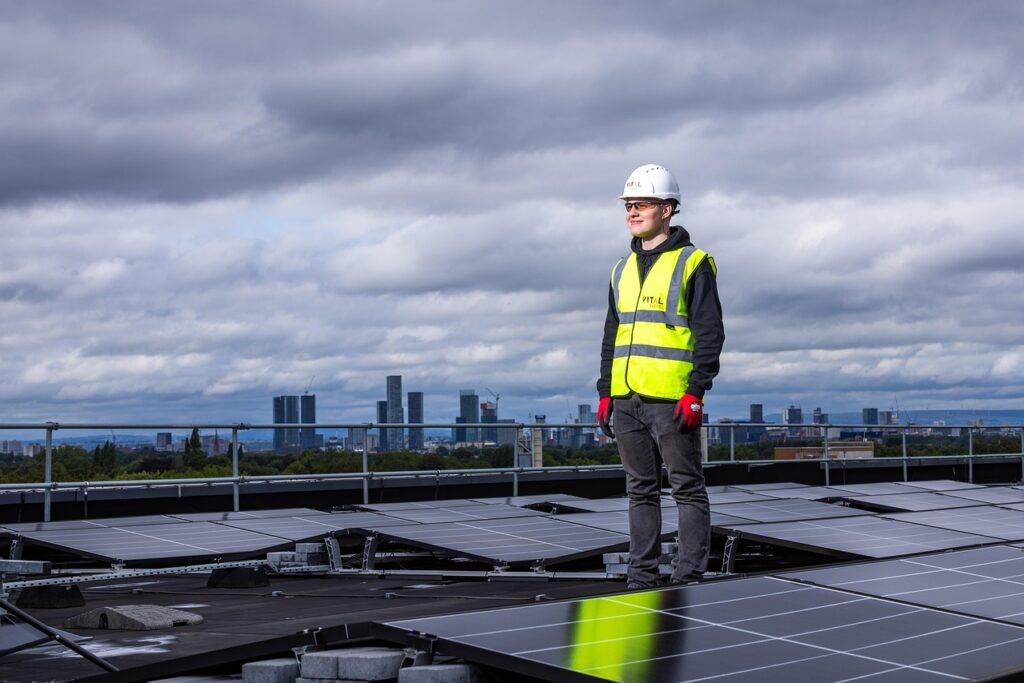Solar panel cladding integrates photovoltaic cells directly into a building’s outer walls, turning the facade into a functional energy generator as well as a protective exterior. This technology allows buildings to produce electricity on-site while maintaining or enhancing their aesthetic appeal. Unlike traditional rooftop panels, solar cladding offers more design flexibility and can be applied as part of new construction or retrofitted on existing structures.
Advanced systems now come prefabricated and ready for quick installation, often combining insulation with solar energy generation. They can serve as rainscreens, windows, or shingles, blending seamlessly with various architectural styles. This approach not only reduces energy costs but also contributes to building sustainability goals without compromising design integrity.
Solar Panel Cladding Overview
Solar panel cladding integrates photovoltaic technology directly into building exteriors, allowing structures to generate electricity while serving as protective facades. It combines building materials with solar cells to provide energy generation, insulation, and added architectural value.
This technology involves multiple types of cladding materials and mounting methods. Its benefits span energy efficiency, thermal regulation, and aesthetic flexibility, making it increasingly common in contemporary building designs.
How Solar Panel Cladding Works
Solar panel cladding consists of solar cells embedded within or attached to exterior cladding materials. These panels capture sunlight and convert it into electrical energy, which is fed back into the building’s electrical system.
The cladding serves dual roles: acting as façade protection against weather and as an energy generator. Connected through electrical wiring, the system often includes inverters that convert direct current (DC) into usable alternating current (AC) for the building.
Installation involves mounting panels using existing fixation methods or custom designs. Ventilated solar facades are common, allowing airflow to improve energy efficiency and thermal regulation.
Types of Solar Panel Cladding
There are several types of solar panel cladding, including photovoltaic (PV) panels integrated into:
- Rainscreen systems
- Prefabricated wall panels
- Building-integrated photovoltaics (BIPV) such as solar shingles and windows
Materials vary from glass-encased panels to flexible films installed on different substrates. Some cladding is unitized for fast installation, while others require stick-built methods. The variety allows adaptation to diverse architectural styles and building requirements.
Advantages of Solar Panel Cladding
Solar cladding provides energy generation, which offsets building electricity use and reduces operational costs. It improves building insulation and contributes to noise reduction.
The cladding also supports design flexibility and can be customized in patterns and colors. This integration reduces the visual impact typically associated with traditional solar panels.
Additional benefits include eligibility for government incentives and potential reductions in carbon taxation. The system can yield fast financial payback, depending on location and building energy demand.
Applications in Modern Architecture
Modern architecture uses solar panel cladding to merge sustainability with aesthetic appeal. Buildings incorporate cladding on façades, walls, and roofs, turning entire surfaces into energy-producing assets.
Architects leverage solar cladding for projects requiring high energy efficiency and environmental certifications. It adapts well in urban environments where roof space may be limited but façade area is ample.
Typical applications include commercial buildings, residential towers, and public infrastructure, enhancing resilience and reducing carbon footprints while providing distinctive design elements.
Design, Installation, and Performance
Solar panel cladding requires careful attention to integration, installation methods, design adaptability, and expected durability. Each factor influences energy output, building compatibility, and long-term maintenance needs.
Key Considerations for Building Integration
Building integration demands precise coordination with structural and architectural elements. The cladding system must align with the building’s load capacities, wind resistance, and thermal requirements.
Compatibility with existing materials and rapid installation support project timelines. Proper electrical connections and weatherproofing are critical to prevent moisture infiltration and energy losses.
The cladding’s weight and dimensions influence mounting system choice. Lightweight and large-format panels reduce installation complexity and structural stress, offering benefits for retrofit and new construction projects.
Installation Processes for Solar Panel Cladding
Installation steps vary by system but typically include mounting a supporting frame onto the building facade. Panels are securely attached and electrical wiring is connected through concealed conduits.
Certified professionals manage insulation, electrical hookups, caulking, and finishing to ensure the facade is weather-tight and compliant with safety standards. Installation speed benefits from prefabricated and modular systems.
Coordination with other trades, such as structural and electrical teams, ensures seamless integration. Proper installation practices minimize performance loss and reduce the likelihood of damage over time.
Aesthetic and Functional Design Options
Solar cladding can mimic traditional facade materials, including glass, stone, wood, and brick, allowing architects to maintain design integrity. Finishes range from glossy and matte glass to textured patterns.
Functionally, cladding panels often serve dual roles: generating energy and providing insulation. System flexibility enables adaptation to varied building geometries and stylistic requirements.
Integration with facade elements like windows or shading devices enhances both appearance and energy efficiency. Designers can select solar products that balance visual appeal with optimal sunlight capture.
Performance Metrics and Long-Term Durability
Performance evaluation focuses on energy yield, conversion efficiency, and facade thermal behavior. Monitoring systems track electrical output and detect faults for maintenance.
Durability depends on panel materials, mounting systems, and environmental conditions. Panels must resist UV exposure, weather stress, and thermal cycling without degradation.
Manufacturers often provide warranties covering 25 years or more, reflecting expected lifespan. Routine inspections and cleaning preserve efficiency and prevent physical damage or moisture ingress over time.




